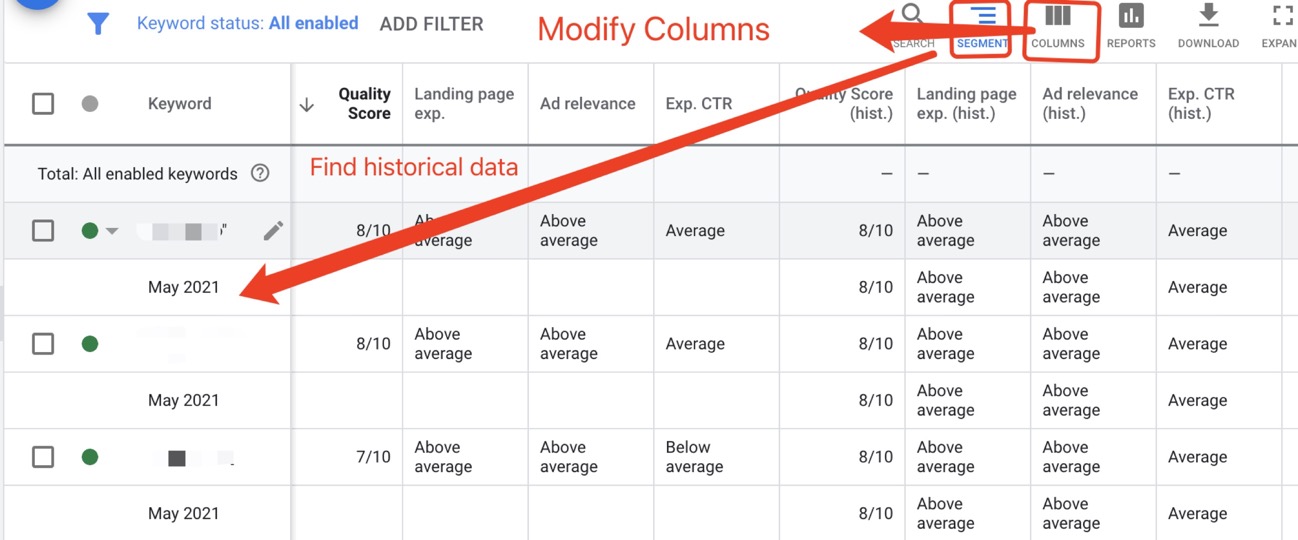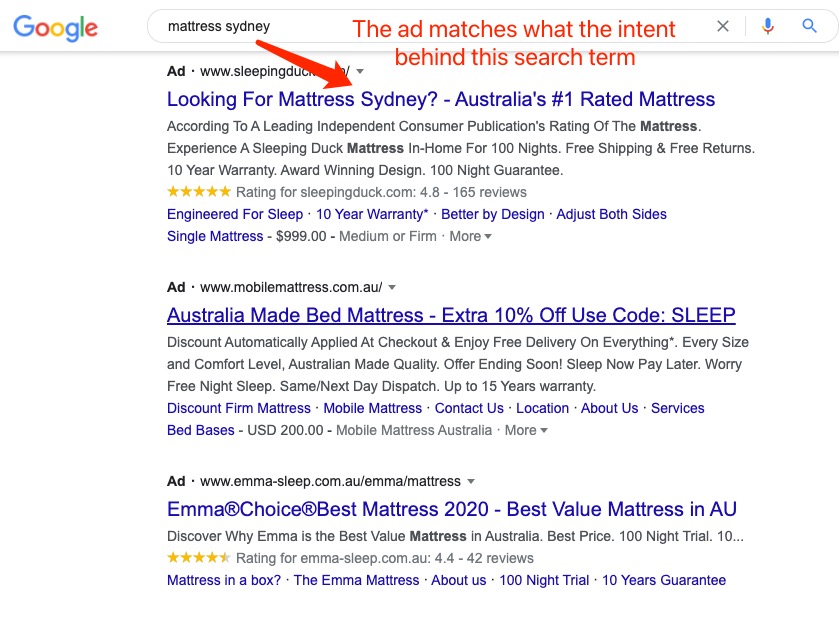3 Steps To Lower Cost Per Click and Improve Ad Quality in Google Ads
Table of Contents (Click to show/hide)









Ad Quality Determines How Much You Pay
Google Ads has the largest pay-per-click (PPC) search engine marketing inventory in the world. With the significant investment in this dominant ad market, paid search marketers often seek ways to increase conversions at the lowest cost. Regardless of the form of bidding strategies, Cost Per Thousand Impressions (CPM) & Cost Per Click(CPC) are the critical inputs on how much you will pay for your result. The CPM represents the standard market price, making it hard to optimise & manipulate. However, you can focus on improving the quality score to get more results without increasing your budget.
But first, let's see a cost per click formula:


(source: 1)
Ad Rank determines the positions in which ads participating in the auction are shown. The better the Ad Rank, the higher the position. Quality Score is a keyword-level evaluator designed to give you an idea of how well your ad quality compares to other advertisers.

Google combines the auction-time ad quality (including expected clickthrough rate, ad relevance, and landing page experience), the max. CPC bid, the Ad Rank thresholds, the competitiveness of an auction, the context of the person's search, and the expected impact of extensions and other ad formats to determine Ad Rank. Thresholds are determined dynamically at the time of each auction based on various factors. With so many factors mixed to determine the ad position, there's always one factor that you can improve - ad quality - Quality Score.
TL;DR version
No matter what you do, make sure you naturally include your bidding keywords in your ad copies and landing pages.
Why ad quality matters
The quality components of Ad Rank are used in several different ways and can affect the following things:
- Ad auction eligibility: Our measures of ad quality help determine the Ad Rank thresholds for your ad, and therefore whether your ad is qualified to appear at all.
- Your actual cost-per-click (CPC): Higher quality ads can often lead to lower CPCs. That means that you pay less per click when your ads are higher quality.
- Ad position: Higher quality ads often lead to higher ad positions, meaning that they can show up higher on the page.
- Eligibility for ad extensions and other ad formats: Ad Rank determines whether or not your ad is eligible to be displayed with ad extensions and other ad formats, such as sitelinks.
Now let's dig in.
Three factors affect your Quality Score:
- Ad relevance.
- Landing page experience.
- Expected CTR.
Let's tackle them one by one.
Step 1: Pull out your quality score report
Search Campaign > Keywords > Columns > Modify columns > Quality Score
As mentioned, the Quality Score is a keyword level metric. Click the "Columns" on the upper right menu to custom your column view to include Quality Score metrics. Remember to save these columns for future quick access.
You will need all the metrics shown below to help you decide your next move.
Note: You can change the periods to see month-to-month and even segment by day to compare the score changes.
Why Historical Quality Score Is Important?
Historical Quality Score metrics can be a lifesaver if you see a "null" value in your current Quality Score view. Ginny Marvin from Google said there are two possible reasons why Google Ads may not show quality score metrics on your campaigns:
A) The keywords don’t have enough exact match impressions
B) The keywords need recent exact match impressions to maintain a quality score and may turn back to null when there isn’t enough recent traffic.
This is a reminder of the importance of selecting the right keyword terms that have exact-match search volume. What's more, you should change the periods to see month-to-month Quality Score metrics while the current data is missing.
You will see these metrics showing the following status:
- "Average" or "Above Average" – This means there are no significant problems with this metric.
- "Below Average" – This means your keyword is expected to perform poorly in terms of CTR. (which means low ad quality)

Step 2: Improve The Ad Relevancy & Expected CTR
These two metrics are often tied together. The expected CTR estimates the likelihood someone will click your ad when it appears for one of your eligible keywords. It assumes the level of the search term matches your keyword and doesn't consider other factors such as device type, ad rank, ad extensions etc. And then, the ad relevancy shows how well a keyword matches the message in your ads. So if you compare these two, you will see the relationship as follows:
- Expected CTR: How well the search term matches your keyword. This is partly based on your ad's historical clicks and impressions
- Ad Relevancy: How well the ad copies matches your keyword. How well the ad copies matches the search queries.
Now you know where to investigate. Let's dig into what would be the problems.
Search term issues:
- Irrelevant searches trigger your ad (especially in DSA).
- You didn't group your keyword wisely.
Ad copies issues:
- Ads are identical in different ad groups.
- You didn't include the keywords in your ad copies.
How do you solve them?
- Group your keywords in a laser-focused theme.
- Run a search term report weekly and add irrelevant search terms to the negative keyword.
- Make unique & tailored ads for each ad group theme.
- Include your keywords in your ad copies, naturally
- Use ad customiser, Keyword insertion, location insertion, business data to show a unique ad for each ad group, keyword and even location.
- Moving low-quality score keywords to a new ad group.
- Using every ad extension (now called asset) possible (Biz name, logo, sitelink, call-out, structured, call, lead form, price, promotion, image, location and more)
Grouping your keywords is like making a sales pitch - you need to present your product in an organised way. For example, if I am selling furniture, I will group my keywords based on product type. If I am selling an app online, I will group my keywords based on the USPs. By identifying a specific theme for the ad group, you will be able to assign the right ads to the right keywords.

But how do you create a unique, tailored ad? It's all about the keywords you chose to bid. If a customer search for "mattress Sydney", making sure your ad includes the location become highly crucial. Ad customiser, keyword insertion and location insertion are the secret weapon that can save your time and improve your ad quality at the same time.

Step 3: Improve The Landing Page Experience
There's a running joke amongst the SEO community that search engine optimisation becomes user experience optimisation (SEO becomes UEO). That's 100% true. And that is not limited to organic search. Google wants all the users to have a good browsing experience while using its product, which means good landing page performance will be rewarded.
Make sure your landing page has the following elements:
- The advertised product should be featured clearly in the hero section.
- Ensure the mobile landing page performance. Google has a tool that will show page speed on mobile and mobile-friendliness.
- Include/reflect the essential part of your ad copies in your landing page textual HTML code.
- Call to action. And communicate to the user what will happen next when they complete an action.
- Pass all core web vitals score.
- Improve Landing Page Experience Quality Score by improving load time, page experience (SEO) & layout.
A True Example Sourced From Google Ads Support
Here’s a simplified example of how Ad Rank works. It doesn’t account for all of the factors discussed above, but instead aims to give you a high-level overview of our algorithms:
Assume five advertisers are competing for a maximum of four ad positions above search results on the Google search results page. The respective Ad Rank of each of the advertisers is, say, 80, 50, 30, 10, and 5.
If the minimum Ad Rank necessary to show above the search results is, say, 40, only the first two advertisers (with Ad Ranks of 80 and 50) exceed the minimum and show above the search results.
If the minimum Ad Rank necessary to show below the search results is 8, then two of the three remaining advertisers (with Ad Ranks of 30 and 10) will show beneath the search results. The advertiser with an Ad Rank of 5 didn’t meet the minimum Ad Rank and so won’t show at all.
For top and absolute top metrics, the advertiser with an Ad Rank of 80 (in the first position above the results) will have 1 impression counting both for top and absolute top, the advertiser with Ad Rank of 50 (in the second position above the search results) will have 1 impression on top, and the advertiser with an Ad Rank of 30 (in the first position below the search results) will have 0 impressions on top or absolute top, same as the advertiser with an Ad Rank of 10 (in the second position below search results).
To improve your share of the top and absolute top location on the search result page, you can:
- Improve the quality of your ads and landing page experience
- Increase your bid
Why ad quality matters
The quality components of Ad Rank are used in several different ways and can affect the following things:
- Ad auction eligibility: Our measures of ad quality help determine the Ad Rank thresholds for your ad, and therefore whether your ad is qualified to appear at all.
- Your actual cost-per-click (CPC): Higher quality ads can often lead to lower CPCs. That means you pay less per click when your ads are higher quality.
- Ad position: Higher quality ads often lead to higher ad positions, meaning they can show up higher on the page.
- Eligibility for ad extensions and other ad formats: Ad Rank determines whether or not your ad is eligible to be displayed with ad extensions and other ad formats, such as sitelinks.
Quality Score Rethink - Update As Of 08 April 2023
Recently Search Engine Land posted an article about Google Ads' Quality Score; questioning the solidity of the metric allowed me to revisit and explore more CPC improvement.
In the article, it mentions several advertisers say the Quality score is a vanity metric (see examples below):
- Zero or blank Quality Score data even if the keywords got more than 5000 impressions & costed thousands of dollars. (Source: Robert Brady's Twitter)
- Unrealistic for B2B keywords with low search volume compared to B2C keywords.
- A fantastic CTR can be downgraded to "Average" due to its relative-data nature (Source: Search Engine Land)


This tells me (and of course, my readers) that Google Ads quality metrics can only be used for direction and should never devote your 120% of effort to it. User experience, in my opinion, is your ultimate king.
I then went through all the articles it referenced and concluded some tactics I found ergonomic; I will list them here and embed them in my article above:
- Improve overall Quality Score by moving low-quality score keywords to a new ad group.
- Improve Expected CTR Quality Score by using every ad extension possible.
- Improve Ad relevancy by including one static RSA and one RSA with as much ad customiser functions as possible.
- Improve Landing Page Experience Quality Score by improving load time, page experience (SEO) & layout
Conclusion
Let's set our goal straight - you want to improve the quality score to get more results without increasing your budget. In short, 1) create a keyword grouping structure that reflects your product's USP 2) include keywords in your ad copies and 3) make sure that your ad copies and landing page are consistent are all your need.
Take advantage of historical quality score data and follow the 3 steps above to make better PPC ads now!
Source(2,3,4,5)









